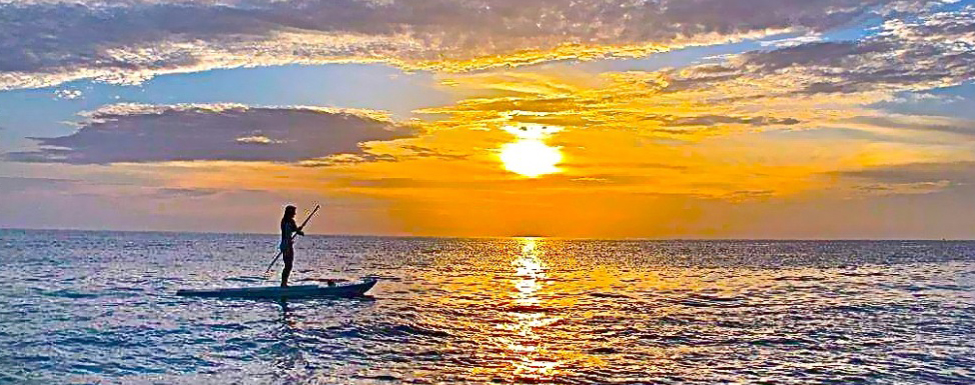Paddle Boarding
“Stand-up Paddle boarding has become a real ‘bucket list’ item,” said Mike Cullinane, who, with his wife, Kirstin, operates Litchfield County Paddlers in New Hartford.
Since the Cullinanes first discovered the sport in 2013, they have made it their mission to introduce as many people as possible in Northwest Connecticut. They have been riding a wave of enthusiasm ever since. Indeed, in 2013, stand-up paddle boarding (SUP) was documented as the outdoor sporting activity with the most first-time participants in the United States.
The new-found popularity is perhaps ironic as stand-up paddling has its origins in pre-history and in all parts of the world. But in modern history, it was peripheral to the better-known surfing until the new millennium, when it suddenly caught fire in Hawaii and eventually jumped the puddle to mainland America.
Unlike traditional surfing, where the boar is propelled by the motion of a wave, stand-up paddle boarders stand on their boards and use a paddle to push themselves through the water. Variations include flat water paddling, racing on lakes, large rivers and canals, surfing on ocean waves, paddling in river rapids, paddle board yoga and even fishing.
The Cullinanes first became aware of paddle boarding when they attended a wooden boat show in Mystic CT. Already avid for water sports, the couple was bitten by the bug and began to explore this inland variation on ocean surfing. They began to notice that paddle boarding was popular along the coast, but had yet to make an impression in Northwest Connecticut.
Alert to the possibilities, the Cullinanes became certified instructors that spring and quickly set up their own business. They rent, sell and will even make customized boards for customers as well as offering lessons for individuals and groups. They regularly offer multiple-lesson sessions at summer camps throughout the region. “We are even going to give lessons at a surprise birthday party,” Cullinane said. “Every year we see more and more people renting our boards.”
Cullinane said the sport is accessible for all ages. He teaches young paddle boarders at summer camps and even had a woman in her 80s show up for one class. “I wouldn’t be surprised if she comes back,” he prophesied. “She did great.”
He said that paddle boards offer a variety of experiences that are not available to those in kayaks or canoes. “Kayaks are great, but they are limited,” he explained. “I can lie down on a paddle board and ‘swim.’ You can jump in the water as much as you want, and if you are in a group, you can change boards as often as you want—it feels like you are walking on air. You can do yoga on the board or compete in a whitewater race. I think people are going to them because they are so versatile.”
But the sport’s very popularity is creating potential problems. Cullinane said that boards are now readily available. “You can buy a board at Ocean State for $399—and they give you a $100 gift card,” he said. “But they just let you walk out the door with no preparation. I see people who are a little older, kind of out of shape and they are out there with no life jackets and no whistle. Someday there is going to be a death. I highly recommend that people have a boating certificate and at least a beginners’ lesson in using the board.”
He said that paddle boards are now listed as being “vessels” and users are required to have life jackets and whistles on board.
Paddle boards come in three lengths: 12, 14 and 17 to 18-feet. The shortest boards are best for paddlers who are under 180 pounds. They are easy to accelerate and are fast in choppy water. The 14-foot boards are the most versatile. They combine many of the best characteristics of stock boards and are almost as fast in calm waters as the longest boards.
“Unlimited boards,” the 17 to 18-foot variety, are the fastest, their speed coming from their long waterline, which gives them a longer glide with each stroke. They are, however, difficult to handle in choppy water and they are harder to transport.
Paddle boards are made of fiberglass, epoxy and/or carbon fiber. In price, they range from a few hundred dollars to around $4,000.
“It can be an investment,” Cullinane admitted.
For those who wish to sample paddle boarding before considering a larger investment, Litchfield County Paddlers rents boards, paddles and personal flotation devices for $40 for two hours; $65 for a half day; $85 for a full day and $195 for a week.
The Cullinanes offer their services on many different bodies of water, including West Hill Lake, Steadman Pond, The Farmington River, Bantam Lake, Lake Waramaug, Long Meadow Pond, Lake Wononskopomuc, Candlewood Lake, Niantic River, The Thimble Islands, Hammonassett Beach and Mohawk Mountain Ski Area's ponds.
Reservations are required. Call 860-480-0714, e-mail thelitchfieldcountypaddler@gmail.com or click on the link below.

